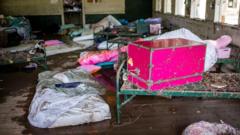Reports reveal troubling details regarding Camp Mystic, a summer camp in Texas where 27 children lost their lives during severe flooding. According to the New York Times and Associated Press, appeals by the camp to alter its risk profile were granted by U.S. regulators, leading to the removal of several of its buildings from Federal Emergency Management Agency (FEMA) flood risk maps. Initially classified as high-risk for flooding in 2011, the camp, situated by the Guadalupe River in a low-lying area, successfully contested these classifications.
FEMA's flood maps are designed to help communities assess flood-related threats, but many experts find it alarming that the camp could challenge and succeed in altering these maps. Syracuse University associate professor Sarah Pralle expressed her bewilderment about the regulatory leniency granted to a venue frequented by children, emphasizing that greater precaution should have been taken.
The newspapers disclosed that various cabins at Camp Mystic lie within hazardous "floodway" zones, where the likelihood of destructive floodwaters is high. Current FEMA guidelines mandate that locations within such zones must hold flood insurance and adhere to stricter regulations for construction. Despite these requirements, the maps were never updated to reflect the camp's appeals, which could have elevated safety measures.
As the state grapples with the aftermath, with 129 fatalities reported and many more missing, President Donald Trump visited affected areas, offering support for recovery efforts. However, he faced backlash for dismissing inquiries regarding the adequacy of warnings and evacuation protocols issued before the catastrophic incident.
The lack of early warning and the timing of the flood, occurring before dawn, contributed significantly to the devastation. The tragedy has opened up critical discussions regarding emergency preparedness and the responsibilities of organizations when it comes to safety protocols for vulnerable populations.





















